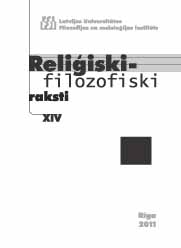Piecu vārdu vērtais bīskaps
The Less-Than-Five-Words Bishop
Author(s): Māris VecvagarsSubject(s): Christian Theology and Religion
Published by: Latvijas Universitātes Filozofijas un socioloģijas institūts
Summary/Abstract: The article is a detailed study of the life and work of Bishop Kārlis Irbe (1861–1934), a man who had been actively involved in the formation of the Evangelical Lutheran Church of Latvia at the beginning of the 20th century, when Latvia gained independence after World War I. K. Irbe was consecrated Bishop of the Evangelical Lutheran Chuch of Latvia in 1922 and resigned the post in 1931, remaining a controversial figure in the ecclesiastical history of Latvia. The title of the article is designed to refer to the very brief mention of K. Irbes` death in the official Year-Book of the Evangelical Lutheran Church of Latvia in 1935. The author holds that the contribution of K. Irbe has not been properly evaluated during the subsequent period, largely due to the very intricate character of the church – state relations in Latvia in the twenties and thirties of the last century. After the signing of the Concordat between the Vatican and the Latvian state in 1922, several legal steps were taken to deal with the property rights of various religious denominations, in particular concerning the ownership of the significant church buildings in Riga. In 1923 the Saeima (Parliament of Latvia) adopted an Act about the Allotment of the Cathedrals to the Latvian Ev.-Lutheran Bishop and to the Bishop of the Roman Catholic Faith in Riga. The Act envisaged to pass the rights of use of the Riga Dome Church and the adjacent buildings to the Evangelical Lutheran Church of Latvia, while the Roman Catholic Churh recived similar rights with regard to St. Jacob`s Church structures. The article discusses in minutest detail the subsequent events, in particular the situation in the thirties, concerning the status of the Dome (re-named Māras) Cathedral Churh that became an object of stormy political debates and drew mass media attention. These discussions included also questions concerning the rights of the German minority in Latvia and other politically sensitive issues. The author of the article holds that the politicalal elite of Latvia of that period displayed lack of proper understanding of the constitutional principle of the church-state separation. The article contains detailed information about the work of the 6th Synod of the Evangelical Lutheran Chuch of Latvia in April – May of 1931, about the inter-denominational relations obtaining at that time, and the political struggles of the period. The respective positions of various political parties and of the fractions of the Saeima are dicussed in detail. The pernicious role of various mass media and the swaying attituded of the public opinion in matters ecclesiastical are exposed. E.g. – on several occasions the plebiscite about the status of the Cathedral buildings came to nothing, due to lack of required quorum.
Journal: Religiski-filozofiski raksti
- Issue Year: XIV/2011
- Issue No: 1
- Page Range: 143-164
- Page Count: 22
- Language: Latvian

